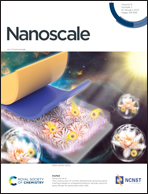Lactose-modified enzyme-sensitive branched polymers as a nanoscale liver cancer-targeting MRI contrast agent†
Abstract
Signal enhancement of magnetic resonance imaging (MRI) in the diseased region is dependent on the molecular structure of the MRI contrast agent. In this study, a macromolecular contrast agent, Branched-LAMA-DOTA-Cy5.5-Gd (BLDCGd), was prepared to target liver cancer. Due to the affinity of lactose to the Asialoglycoprotein receptor (ASGPR) over-expressed on the surface of liver cancer cells, lactose was selected as the targeting moiety in the contrast agent. A cathepsin B-sensitive tetrapeptide, GFLG, was used as a linkage moiety to construct a cross-linked macromolecular structure of the contrast agent, and the contrast agent could be degraded into fragments for clearance. A small-molecular-weight molecule, DOTA-Gd, and a fluorescent dye, Cy5.5, were conjugated to the macromolecular structure via a thiol–ene click reaction. The contrast agent, BLDCGd, had a high molecular weight (81 kDa) and a small particle size (59 ± 12 nm). Its longitudinal relaxivity (12.62 mM−1 s−1) was 4-fold that of the clinical agent DTPA-Gd (3.42 mM−1 s−1). Signal enhancement of up to 184% was observed at the tumor site in an H22 cell-based mouse model. A high accumulation level of BLDCGd in the liver tumor observed from MRI was confirmed from the fluorescence images obtained from the same contrast agent. BLDCGd showed no toxicity to HUVECs and H22 cells in vitro, and low blood chemistry indexes and no distinct histopathological abnormalities were also observed in vivo after injection of BLDCGd since it could be metabolized through the kidneys according to the in vivo MRI results of major organs. Therefore, the branched macromolecule BLDCGd could have great potential as an efficacious and bio-safe nanoscale MRI contrast agent for clinical diagnosis of liver cancer.



 Please wait while we load your content...
Please wait while we load your content...